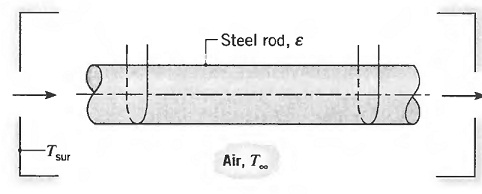Discuss the below in detail:
Q: Long stainless steel rods of 50-mm diameter are preheated to a uniform temperature of 1000 K before being suspended from an overhead conveyor for transport to a hot forming operation. The conveyor is in a large room whose walls and air are at 300 K.
(a) Assuming the linear motion of the rod to have a negligible effect on convection heat transfer from its surface, determine the average convection coefficient at the start of the transport process.
(b) If the surface emissivity of the rod is 8 = 0.40, what is the effective radiation heat transfer coefficient at the start of the transport process?
(c) Assuming a constant cumulative (radiation plus convection) heat transfer coefficient corresponding to the results of parts (a) and (b), what is the maximum allowable conveyor transit time, if the centerline temperature of the rod must exceed 900 K for the forming operation? Properties of the steel are k = 25 W/m · K and a = 5.2 x 10-6 m2/s.
(d) Heat transfer by convection and radiation are actually decreasing during the transfer operation. Accounting for this reduction, reconsider the conditions of part (c) and obtain a more accurate estimate of the maximum allowable conveyor transit time.
